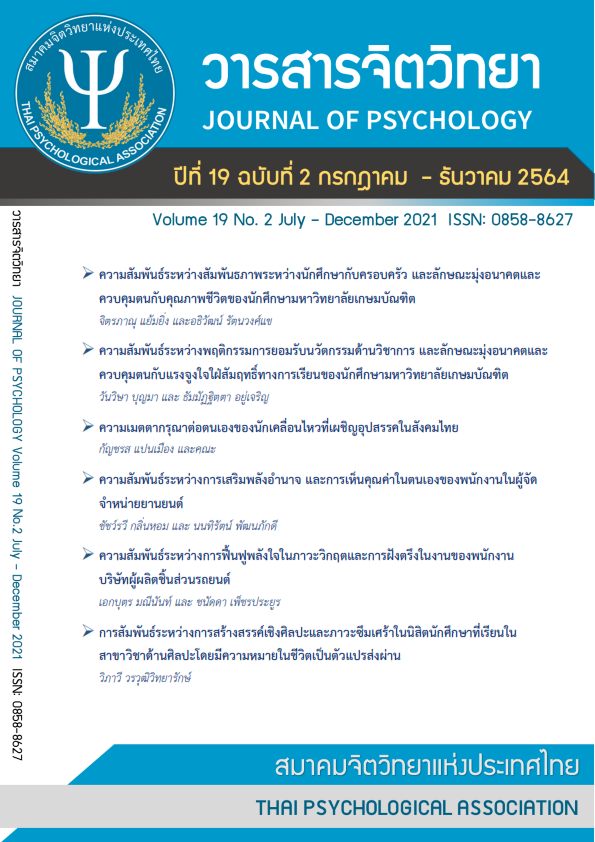Relationships Between Resilience Quotient and Job Embeddedness of Employees of Auto-parts Manufacturer
Keywords:
Resilience quotient, Job embeddedness, Employees of auto- parts manufacturerAbstract
As a result of the economic recession and the crisis of COVID-19 pandemic, employees in the organization are greatly affected in many ways. If employees have high resilience quotient, they are likely to be related with job embeddedness which is beneficial to the organization. The objectives of this research are (1) to study levels of resilience quotient and job embeddedness of employees of auto- parts manufacturer, (2) to study relationship between resilience quotient and job embeddedness of employees of auto-parts manufacturer. Participants were 316 employees of auto-parts manufacturer by using a sampling method. The instrument was a questionnaire. It has reliability greater than 0.7. The statistics used to analyze data were frequency percentage, mean, standard deviation and Pearson Product Moment Correlation. The results revealed that (1) Levels of resilience quotient and job embeddedness of employees of auto-parts manufacturer were at a high level ( = 4.06, 3.74 SD = 0.38, 0.40 respectively), (2) There was a positive relationship between resilience quotient and job embeddedness of employees of auto-parts manufacturer with a statistical significance at .01 level (r=.507). The facet of resilience quotient; emotional stability, encouragement and coping positively correlated with job embeddedness of employees of auto-parts manufacturer at the statistical significance level of .01 (r=.424, .446 and .479 respectively). From such relationships, it can be a guideline for management to consider improving and developing organizational policies. and continue to organize promotional activities in next phase.
References
กรมสุขภาพจิต. (2563). เปลี่ยนร้ายกลายเป็นดี RQ พลังสุขภาพจิตพาคุณก้าวผ่านวิกฤตและความไม่แน่นอนของชีวิตได้อย่างสง่างาม. พิมพ์ครั้งที่ 4. บริษัท บียอนด์พับ
ลิสชิ่ง จำกัด.
ชินกร น้อยคํายางและปภาดา น้อยคํายาง. (2555). ปัจจัยที่ส่งผลต่อดัชนีความสุขในการ ทํางานของบุคลากรสํานักหอสมุดกลาง มหาวิทยาลัยศรีนครินทรวิโรฒ. รายงาน
การวิจัย. สํานักหอสมุดกลาง มหาวิทยาลัยศรีนครินทรวิโรฒ.
ทิพย์สิริ กาญจนวาสี และศิริชัย กาญจนวสี. (2559). วิธีวิทยาการวิจัย. สำนักพิมพ์จุฬาลงกรณ์มหาวิทยาลัย.
บุญธรรม กิจปรีดาบริสุทธิ์และพิสมัย เสรีขจรกิจเจริญ. (2560). ระเบียบวิธีการวิจัยทางการสาธารณสุข: กรณีศึกษาความสัมพันธ์ระหว่างตัวแปร. พิมพ์ครั้งที่ 1. จามจุรีโป
รดักท์.
ไพศาล วรคํา. (2559). การวิจัยทางการศึกษา. ตักสิลาการพิมพ์.
พงษ์เทพ สันติกุล. (2560). การวิจัยทางวิทยาศาสตร์สังคม สำหรับนักศึกษาและผู้ปฏิบัติงาน สวัสดิการสังคมและสังคมสงเคราะห์. สํานักพิมพ์มหาวิทยาลัยธรรมศาสตร์.
พิสณุ ฟองศรี. (2552). การสร้างและพัฒนาเครื่องมือวิจัย. ด่านสุทธาการพิมพ์.
ยุทธ ไกยวรรณ์. (2562). ระเบียบวิธีวิจัยทางด้านการaโรงแรมและการท่องเที่ยว. สำนักพิมพ์จุฬาลงกรณ์มหาวิทยาลัย.
สุดารัตน์ พงษ์พิทักษ์. (2559). บีโอไอกับพัฒนาการอุตสาหกรรมยานยนต์. วารสารส่งเสริมการลงทุน.
http://www.faq108.co.th/common/topic/auto_industry.php
Cronbach, L. J. (1990). Essentials of Psychological Testing. 5th edition. Harper & Collins.
Jeonghwa Cho., Junghee Yu., Kawoun Seo. (2019). “Effects of Resilience and Authentic Leadership on Job Embeddedness of Clinical Nurses in
Korea”. Indian Journal of Public Health Research & Development,10(11), 4557-4562.
Krejcie, R. V. and Morgan, D. W. (1970). “Determining sample size for research activities.” Educational and Psychological Measurement, 30,
-610.
Mitchell, T.R., et al (2001). “Why people stay : Using job embeddedness to predict voluntary turnover”. Academy of Management Journal, 44,
-1121.
Downloads
Published
How to Cite
Issue
Section
License
Copyright (c) 2021 Thai Psychological Association

This work is licensed under a Creative Commons Attribution-NonCommercial-NoDerivatives 4.0 International License.
บทความที่ได้รับการตีพิมพ์เป็นลิขสิทธิ์ของสมาคมจิตวิทยาแห่งประเทศไทย
ข้อความที่ปรากฎในบทความแต่ละเรื่องในวารสารวิชาการเล่มนี้เป็นความคิดเห็นส่วนตัวของผู้เขียนแต่ละท่านไม่เกี่ยวข้องกับสมาคมจิตวิทยาแห่งประเทศไทย แต่อย่างใด ความรับผิดชอบองค์ประกอบทั้งหมดของบทความแต่ละเรื่องเป็นของผู้เขียนแต่ละท่าน หากมีความผิดพลาดใด ๆ ผู้เขียนแต่ละท่านจะรับผิดชอบบทความของตนเองแต่ผู้เดียว





